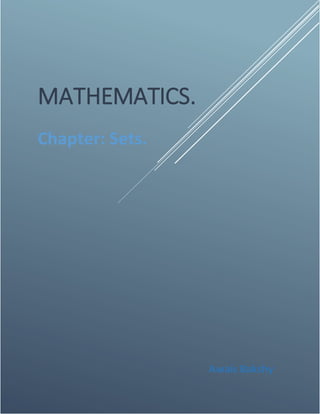Number system
- 2. Mathematics. Chapter: Number Systems. Number System. Number system is the way to represent a number in different forms. Real Numbers. The sum of rationaland irrationalnumbers is calledreal numbers. Real number = RationalNumbers+ IrrationalNumbers. Denoted By Capital R Rational Numbers. A rationalnumber is a number which can be put in the form 𝑃/q) where p, q ϵ Z ∧ q ≠ 0. The number√16, 3, 7, 4 etc. are rational numbers. √16 Can be reduced to form 𝑝 𝑞⁄ where p, q ϵ Z and q ≠ 0 because √16 =4=4 1⁄ . Denoted by Capital Q.
- 3. IrrationalNumbers. Irrational Numbers are those numbers which cannot be put into the form 𝑝 𝑞⁄ where p, q ϵ Z and q≠0. The numbers√2, √3, √5, √5 16 . Denoted By Capital 𝑄, (Q Dash) Fractions. Numbers that can be written as ratios of 2 integers E.g. 2 3 , 6 8 , 2 7 , 3 5 . Integers. Positive Integers + 0 (Zero) + Negative Integers. Denoted By CapitalZ. Z= {0, ±1, ±2, ±3, ±4, ±5, ±6, ±7, …} Negative Integers. Denoted by 𝑍′ (Z Dash) 𝑍′ = {-1,-2, -3, -4, -5, -6, …} Natural Numbers. N ={1, 2, 3, 4, 5, 6, 7, …} Whole Numbers.
- 4. W = {0, 1, 2, 3, 4, 5, 6, 7,8, …} Even Numbers. E= {0, 2, 4, 6, 8, 10, 12, 14, …} Odd Number. O ={1, 3, 5, 7, 9, 11, 13, …} Properties of Real Numbers. Addition Laws: 1. Closure Property w.r.t addition. ∀ a, b ϵ R,a+b=R (∀ Stands for “for all”) 2. Associative propertyw.r.t addition. ∀ a, b, c ϵ R, a+(b+c)=(a+b)+c 3. Additive identity. ∀ a ϵ R , ∃ 0 ϵ R such that a+0=0+a=a (∃ stand for “there exist”) 0 (read as zero) is calledthe identity element of addition. 4. Additive inverse. ∀ a ϵ R, ∃ (-a) ϵ R such that a+(-a)=(-a)+a=0 5. Commutative Property w.r.t addition. ∀ a, b ϵ R, a+b=b+a
- 5. Multiplicative Laws: i. Closure Property w.r.t Multiplication. ∀ a, b ϵ R,a.b=R (a.b is usually written as ab) ii. Associative propertyw.r.t multiplication. ∀ a, b, c ϵ R, a(bc)=(ab)c iii. Multiplicative identity. ∀ a ϵ R , ∃ 1 ϵ R such that a.1=1.a=a 1 is called the multiplicativeidentity of real numbers. iv. Multiplicative inverse. ∀ a(≠0) ϵ R, ∃ (𝑎−1 ) ϵ R such that a. 𝑎−1 = 𝑎−1 .a=1 (𝑎−1 is also written as 1 𝑎 ) v. Commutative Property w.r.t addition. ∀ a, b ϵ R, ab=ba DistributivePropertyof Multiplicationoveraddition. ∀ a, b, c ϵR such that; a (b+c)= ab+ac ( left D.Law) (a+b) c= ac+bc ( Right D.Law)
- 6. Exercise. Q No 1. Name of the properties of real numbers given below. a. 25+48=48+25 b. √11 ×√3=√3×√11 c. √5(3+7)=√5 3 +√5 7 d. ( 11 2 + 9 5 ) + 7 10 = 11 2 +( 9 5 + 7 10 ) e. 0 + 4 5 = 4 5 + 0 f. ( √5 2 × 1) = √5 2 Q No 2. Write the additive and multiplicativeinverse of the following. a. 1 𝑎 b. 1 c. √57 d. 0 e. √3 7 f. √5 − 2 g. −7
- 7. Q No 3. Which of the followingset have the closure property w.r.t addition and multiplication. a. 0 b. {0,-1} c. {0, 1} d. {-1, -2, -3, …} e. Set of real numbers. f. Set of rational numbers. g. Set of whole numbers. Q No 4. Which of the followingset have additive and multiplicative identity. a. Set of real numbers. b. Set of whole numbers. Q No 5. Which of the followingsets have the additive and multiplicativeinverse. a. Set or rational numbers. b. Set of prime numbers. c. Set of real numbers. d. Set of integer numbers.

